As early as the 16th century, Iberian Jews who had converted to Catholicism in order to escape persecution or expulsion came to Spanish and Portuguese colonies in the New World where they hoped to be free of stigma. But soon the Inquisition followed them, seeking out those who continued to practice Jewish rituals in secret. A new exhibit at the New Mexico History Museum in Santa Fe tells what happened to some of these crypto-Jews. Rich Tenorio writes:
Fractured Faiths: Spanish Judaism, the Inquisition, and New World Identities is on display . . . through December 31. In this comprehensive exhibition, viewers can see artifacts borrowed from over twenty institutions from Europe and the Americas—many brought together for the first time. . . .
Established in Spain in 1478, the Inquisition began active investigations in 1480. The next 40 years would see a wave of persecution of crypto-Jews. . . . in Spain and to some extent in the Americas. . . .
In Mexico City during the 1590s, a second wave of persecutions arose, stretching over a decade. Its victims included Don Luis de Carvajal, a colonial governor of New Mexico, and his family.
More about: American Jewish History, History & Ideas, Inquisition, Museums, Sephardim


